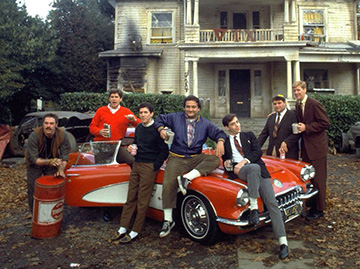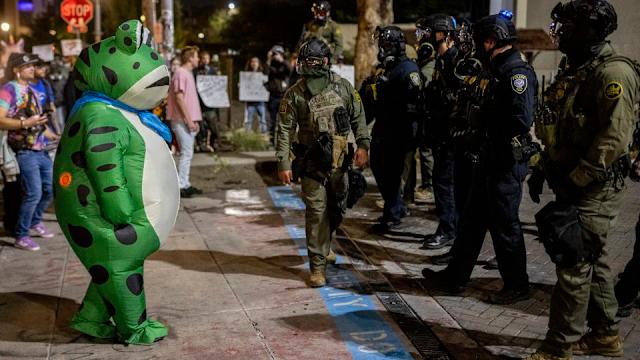You pass them on the street; you’ve probably seen them on TV or have been in one. You might not remember it, but you were there. Some might call them rave houses, fab pads or even rage cages.
The party house is a very unique place in the culture of college and is where many young adults partake in activities and behavior that many might frown upon and some might applaud.
While one might pass these houses on the way to class or work, many questions come to mind when observing the façade of these structures.
Some might ask who lives here or what would compel a person to live in this house? Others might ask how do they deal with the noise and who cleans up after the many “soirees” that occur in these houses.
A couple of people who know first-hand the effects of life in a party house are Mark Mullins and Eli Kerr.
The two, seniors now at Gannon University, have been living off campus since junior year and have been friends since sophomore year.
Their home is not one you would expect to be a party house. With clean carpets, fresh furniture and a quiet atmosphere, you might think you entered a temple from all the positive energy that hits you when you walk through the door.
Upon walking into the house, you are first greeted in the mudroom by an art table where a painting is always being worked on.
You will also hear the muffled sounds of drums and bass coming from Eli’s room, where he is always whipping up a new rap or creating a new beat.
Overall the atmosphere is pretty relaxed, from the breeze of the cool Erie autumn air flowing through the open windows, to the smell of incense that masks the stench of two-week-old laundry. The overall atmosphere of the house is not one you would expect from people who formerly occupied a party house.
When something needs to be done around the house, you can guarantee it will get done. Maybe not at that moment, but it’ll get done eventually. That’s what the atmosphere is like in the house.
While the vibe here is pretty chill, sometimes there are parties. However, the residents tend to do a good job of keeping the party level and never let it get out of control. This type of knowledge that helps them keep the house nice comes from their experiences of living in a party house.
So, what made them think living in a party house was a good idea and what were the first couple of weeks like?
Both Kerr and Mullins lit up with the memories of last year’s party house, which they dubbed The Warehouse, due to both its appearance and size. Located at 423 W. Eighth St., The Warehouse was a massive duplex that housed eight people in the front stack and an additional 10 in the back stack. The complex included a courtyard, cameras and, of course, the party hall. This massive space was used for parties and soirées that the occupants would throw.
So, what would compel someone to live in an atmosphere with so many people and so much noise?
Kerr said the main reason he wanted to live there was because communal living with best friends sounded like the best thing for him.
“The idea of an indestructible fortress of friendship was intoxicating, both literally and figuratively,” Kerr said as he laughed.
Mullins said living with his “best buds” was amazing, but he warned that it’s not always the best idea due to the tensions that arise from the close living quarters.
While living with these people for so long had its ups and downs, the first couple of months, or as some might call “the honeymoon days,” were amazing, according to the two. With parties every weekend and constant fun spending time with friends at their house, living in The Warehouse seemed like heaven to Kerr and Mullins.
Even when there wasn’t a party going on, there still was one happening, it felt like to the two. Being around their best friends and living together had seemed like the best decision the two had ever made.
Kerr described the environment as “unimaginably lit,” with lots of different people exhibiting many different vibes that most of the time were good.
However, while the first couple of months felt like living with family, this would take a turn and everything would eventually fall apart.
Through the following months the atmosphere of constant noise and people coming and going through their house would get to the minds of the two. Eventually, this fortress of friendship started to crumble.
With the close living quarters and constant noise, everybody was reaching their individual breaking point from living in this situation for so long.
Mullins said that his least favorite part of living in the house was being alone there when everyone would leave for holidays. Mullins, who had to work during the holidays, had to stay on campus during those times.
“The place was very ominous,” Mullins said. “If you were alone, you felt alone
“However, on the upside you had this whole place to yourself.”
Eli’s breaking point occurred toward the end of their lease when they had one month left in The Warehouse. Kerr said this happened when one of his roommates decided to throw a party without informing any of the other housemates.
While there were both ups and downs to living is this house, both Kerr and Mullins recommend this type of living to anyone who is interested in this atmosphere.
“If you like constant social clutter, then go for it,” Mullins said. “I loved living with people who I liked.”
In addition to that, Kerr added, “If you feel like you can handle it, then go for it, but don’t go into it without thinking about your decision first.”
Some of Mullins and Kerr’s greatest and most memorable experiences took place in The Warehouse. From creating art through drawing on the party room walls to hanging out with friends all the time, this place had a positive impact on the two.
For many students, choosing whether to live on or off campus can be a big decision. For Doug Flagg and Maciej Skrzypczak it was a decision that resulted in them choosing to live in a party house off campus.
Flagg said he didn’t decide to live in a party house because of the atmosphere. He made the decision because he had nowhere else to stay on campus, plus he wanted to live with his best friends.
So far, the experience has been interesting, according to Flagg. A little stress here and there dealing with the parties, but they learned how to deal with people in their house.
Flagg recalled the best experience so far has been the party they threw in July where many of his old friends from high school came up to visit. However, the worst part, according to Flagg, has been the cleanup and responsibility that comes with living in a party house.
When it came to the first couple of weeks, Flagg and Skrzypczak had two different experiences with getting used to their new lives. Skrzypczak enjoyed throwing huge parties with all of his friends while Flagg wasn’t around a lot and was still settling into living independently.
With the reputation held by this way of living, the party house has been a fear of many parents when sending their kids away to school.
While many believe this to be a negative atmosphere, Flagg and Skrzypczak beg to differ. “It depends on the person, not the atmosphere,” says Skrzypczak.
Flagg added, “It depends on how you control the atmosphere around you and how you handle the situations that arise from it.”
Mullins and Kerr also agree with how the poor image of the party house lifestyle portrayed by the media is wrong.
“The rep is often bad, but sometimes it can be necessary for students to find themselves and meet other people,” Kerr said. “However, while this can be a positive atmosphere, it can also be dangerous.”
The media have presented many stories about the bad influences party houses have on students whether that’s through acts of hazing or encouragement of risky behavior.
“It is up to the person living in the house to make the decisions that are best for them,” Kerr said. “You have to learn how to think and act responsibly, which is something that is learned through being in the environment.”
Mullins said that most of the time, people don’t know the party style — they think it’s constant immaturity.
“But there’s more responsibility and hospitality that one has to learn in order to live in a party house,” Mullins added.
Living on campus is a staple to the full college experience. From learning to live with others and how to live independently, this can be a very positive influence on the growing young adult. While many things can distract someone in these environments, many things can also help the student grow as a person.
Kerr added another bit of insight toward the experience of living in a party house.
“I feel like we are not here [on campus] for a long time,” he said. “We’re here to make relationships through parties and other social interactions. I learned a lot more about human interaction that year living with seven people than I did in school.”
GABE FULGENZIO
[email protected]








